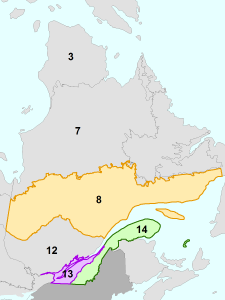The centennial celebrations are far from over in Canada!
On December 7, 2016, at an event at the Canadian Embassy in Washington, DC marking the 100th anniversary of the ratification of the Migratory Bird Convention, the United States marked the end of their centennial celebrations. Delegates from North, Central and South American countries received the call to develop a Hemispheric Vision for bird conservation for the next 100 years. The purpose of the vision is to be used as a launching pad to expand collaboration beyond North American countries and to partner in all-bird conservation across the Western Hemisphere. The draft vision was prepared by Canadian, American and Mexican wildlife agencies; feedback is welcomed and, in fact, appreciated! You can provide any comments or questions before April 15, 2017 at the following email address: vision@nabci.net. In addition to the new vision, the ratification celebration featured art works by students from Mount Allison University; pictures of these same pieces will be displayed on the Confederation Boulevard in Ottawa for Canada’s 150th anniversary. The centennial celebrations will continue in Canada throughout 2017 in honour of 100 years of the Migratory Birds Convention Act (1917).
NABCI-Canada – Update
The NABCI-Canada Executive Council has been hard at work behind the scenes planning the next steps for NABCI-Canada. The Executive Council is comprised of Bob McLean (Canadian Wildlife Service – chair), Steven Price (Bird Studies Canada) for ENGOs, David Ingstrup (Canadian Wildlife Service & Prairie Habitat JV) for the NAWMP Habitat Joint Ventures, Tara Shea (Mining Association of Canada) for industry, Jim Duncan (Manitoba) for the Provincial and Territorial Wildlife Directors, and Veronica Aponte (interim NABCI coordinator). The Executive Council is working to renew NABCI-Canada in a way that it will stimulate the engagement of partners in order to bring an added value to bird conservation in Canada. The NABCI-Canada Council is planning to meet this fall to discuss NABCI-Canada’s five-year Strategic Plan as well as an implementation strategy for the recommended actions found in the State of North America’s Birds, Partners in Flight Conservation Plan and Bird Conservation Region strategies.
Stories from the Field
Nature Conservancy of Canada Implements Bird Conservation Region Strategies in Quebec, written by Veronica Aponte (NABCI-Canada interim coordinator) with the help of Pierre Aquin, CWS Quebec regional biologist
 In 2013, prior to the expansion of the Habitat Stewardship Program’s Prevention Stream, the Canadian Wildlife Service began providing funding to the Nature Conservancy of Canada in Quebec to implement recommendations in NABCI’s Bird Conservation Region (BCR) Strategies 8, 13, and 14. One of the goals of this multi-faceted project was to demonstrate the feasibility of North American Waterfowl Management Plan (NAWMP) implementation strategies for birds other than waterfowl. Several direct on-the-ground conservation and stewardship actions have been undertaken over the course of the last four years on important migratory bird sites in these three BCRs.
In 2013, prior to the expansion of the Habitat Stewardship Program’s Prevention Stream, the Canadian Wildlife Service began providing funding to the Nature Conservancy of Canada in Quebec to implement recommendations in NABCI’s Bird Conservation Region (BCR) Strategies 8, 13, and 14. One of the goals of this multi-faceted project was to demonstrate the feasibility of North American Waterfowl Management Plan (NAWMP) implementation strategies for birds other than waterfowl. Several direct on-the-ground conservation and stewardship actions have been undertaken over the course of the last four years on important migratory bird sites in these three BCRs.
In BCR 8, the Nature Conservancy of Canada (NCC) is currently involved in the conservation of endangered bird species habitat in the “Côte-Nord” of Quebec. The NCC has been involved in population surveys of the Red Knot and conservation actions aimed to protect important habitat located on private land. These efforts are complementary to those being led by the Canadian Wildlife Service in the area of the Mingan Archipelago National Park Reserve where the Canadian Wildlife Service monitors and follows juvenile migration of Red Knots.
In the central area of BCR 13, on Île-aux-Grues, the NCC has established contact with private landowners to implement conservation and steward-ship action to protect the upper marsh, a priority area for bird conservation. As of today, 30 ha (74 acres) have been protected. These lands are now managed for the benefits of a number of bird species. Stewardship actions such as invasive species control, grass management and habitat interventions have been ongoing since the beginning of the project. Moving westward to Île-de-Grâce in the delta near the headwaters of lac St-Pierre near Sorel, several farmers agreed to follow beneficial management practices and mow after July 15 to avoid destroying migratory bird nests. In addition, farmers restored an old barn to make it more suitable for Barn Swallows to nest in. Finally, in riparian and agroforest habitats in the Outaouais region of BCR 13, expert ornithologists delivered training sessions on conducting non-waterfowl bird surveys.
On the Magdalen Islands in BCR 14, the NCC efforts to raise awareness among landowners about beneficial management practices were fruitful; a number of voluntary habitat stewardship agreements were signed as a result. In addition, the NCC is endeavoring to achieve a balance between recreational tourist activities (e.g., ATV use) and habitat protection on these islands.
The Nature Conservancy of Canada in Quebec solicited the Canadian Wildlife Service interest to implement these special projects to achieve NABCI and BCR strategies objectives for birds other than waterfowl.

